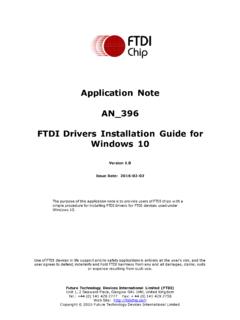Transcription of Installing Software from an .ISO File or .IMG File
1 Installing Software FROM AN .ISO FILE OR .IMG FILE To install Software on your computer from a downloaded file that is in .iso format or .img format, such as is commonly downloaded from the MSDNAA (DreamSpark) Software site, you must either: For Windows 7 PCs: Use appropriate extraction Software (such as 7-Zip) to extract the compressed installation files from within the .iso file or .img file to your computer s hard drive, and then install the Software from these files. For Windows 8 or Windows 10 PCs: Use the built-in utility to access the installation files within the.
2 Iso file or .img file, and then install the Software from these files. WINDOWS 7: 7-Zip is a free Windows Software utility that can be used to extract the installation files from an .iso file. (7-Zip is also a good all-around compression/decompression utility.) This utility can be downloaded from the following web address: On that web page, click the download link near the top of the page. (There are options for both 32-bit and 64-bit versions of Windows. If you are unsure, download the 32-bit version.) Save the downloaded file in a folder of your choosing. (Some browsers may automatically save the file in the Downloads folder on the computer.)
3 After the download is complete, locate the downloaded file and run it to install the 7-Zip utility. (In some situations, you may be asked to reboot your computer in order to complete the installation .) Extracting Files from an .ISO File or .IMG File Once 7-Zip has been installed, it is easy to extract installations files from a downloaded .iso file or .img file. To do so, follow these steps: 1. Using Windows Explorer, locate the .iso file or .img file from which you wish to extract files. 2. Right-click on the filename. From the pop-up menu that appears, select 7-Zip.
4 From the second-level pop-up menu that opens, select Open archive . (Note: In some situations, the 7-Zip Software may not be present in the pop-up menu. In such situations, you can open the 7-Zip Software from the Windows Start menu and load the .iso file or .img file from within the 7-Zip program.) 3. A 7-Zip dialog box will open, showing the contents of the .iso file. In the tool bar of the dialog box, click the button labeled Extract . You will then be given an opportunity to specify the location on your hard drive to which you wish to extract the files. After specifying your desired location, click the OK button and the files will be extracted.
5 4. You may now use whatever procedure is necessary ( , running a file) to install the Software on your computer. WINDOWS 8 OR WINDOWS 10: Windows 8 and Windows 10 have the capability of handling .iso and .img files directly built-in, so no additional Software is necessary. Accessing Files from an .ISO File or .IMG File 1. Using File Explorer, locate the .iso file or .img file from which you wish to extract files. 2. Double-click the .iso file or .img file. This causes the file to be mounted as if it were a disc inserted into a DVD drive ( , drive D:). In File Explorer, locate the drive letter representing the mounted file and click on it to display the files within it.
6 3. You may now use whatever procedure is necessary ( , running a file) to install the Software on your computer. 4. After the installation is complete, you need to unmount the file as if it were a disc inserted into a DVD drive. Thus, in File Explorer, locate the drive letter for the mounted file ( , D:) and right-click on it. From the pop-up menu that appears, click on the Eject option.
